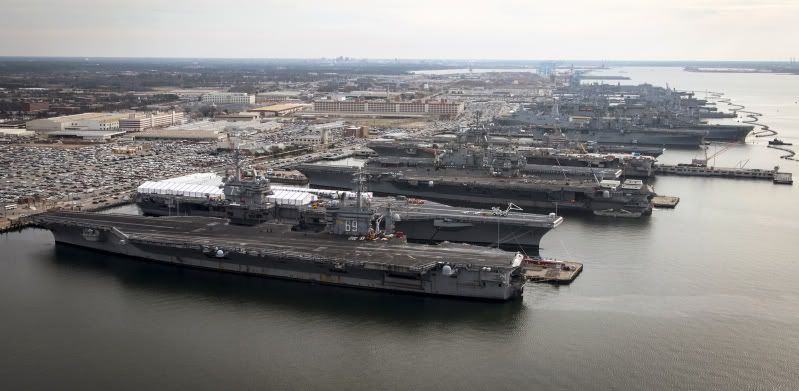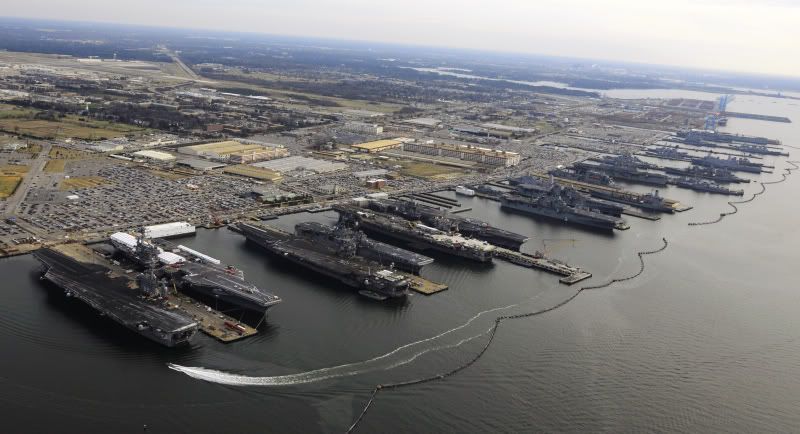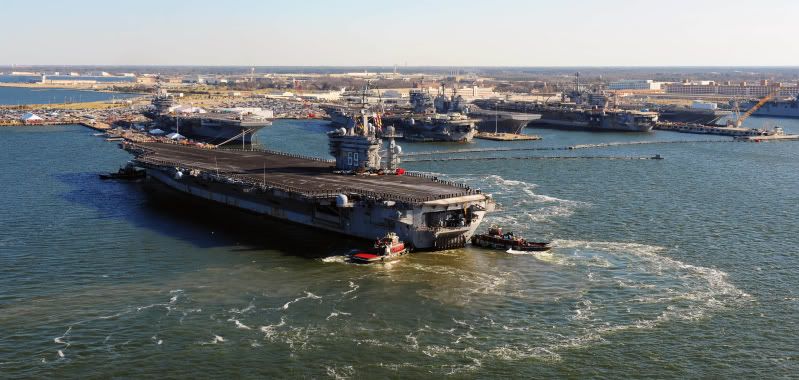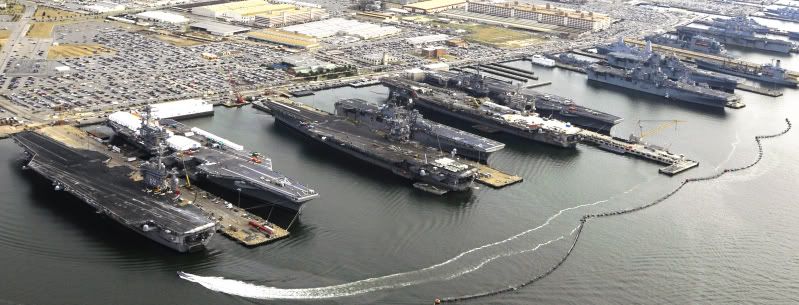You are using an out of date browser. It may not display this or other websites correctly.
You should upgrade or use an alternative browser.
You should upgrade or use an alternative browser.
Aircraft Carriers II (Closed to posting)
- Thread starter Jeff Head
- Start date
- Status
- Not open for further replies.
Of course the landing gear is pretty robust, you want to land on it without breaking it. Land based aircraft are designed for a vertical speed at touch down of 3 m/s, and the same will be true for Harrier and Lightning II - except for F-35C. That one and other carrier based aircraft are designed for a vertical speed of 6 m/s.The Harrier's landing gear is pretty robust, as is the Lightning's. They have to withstand being dropped vertically onto the deck. The point everyone seems to be missing though, is the purpose of the ramp. It is to get your aircraft off the deck BEFORE you have achieved fully wingborne flight. If you can get enough airflow over your wings by the time you reach the end of the deck, then you don't need the ramp as you are already flying. The US experimented with ramps in the 80s as a landbased solution to possible combat loss of runways, for jet fighters. These aircraft could be launched into the air in a fraction of the distance needed on a conventional runway. They didn't magically speed up in a shorter distance, they still needed the same distance as before to go from zero to flying speed, the ramp just got then off the ground early, after which they still had to accelerate (in the air) to flying speed before they dropped back to earth.
Remember, CTOL: Start Takeoff Roll, Reach Flying Speed, Fly.
Ski Jump Takeoff: Start Takeoff Roll, Fly, Reach Flying Speed.
And of course it is the purpose of the ramp to get the aircraft off the deck before reaching fully wing borne flight. That reduces the deck real estate needed for take off and leaves more room for spotting aircraft and doing whatever else you want to do on deck. It is the duty of the engineers to design ship and aircraft, and of the crew to develop the necessary proficiency, to achieve an acceptable level of safety combined with an acceptable rate of production - number of aircraft launched per hour, day, week, whatever .
That is a stunning picture and a rare one at that where almost the entire flattop fleet is at the home base
What is missing is
USS Theodore Roosevelt CVN-71
USS Ponce LPD-15
And a San Antonio Class LPD
CVN-71 in in the Huntington Ingalls Newport News shipyard finishing up her RCOH...Refueling and Complex Overhaul.
The Ponce is now home-ported in Bahrain.
And if you look at this link you will see two San Antonio class LPDs.
I see four Nimitz class carriers (active) and the Enterprise, now decommissioned. I see four Wasp LHD class Amphibious vessels and two San Antonio class LPDs.CVN-71 in in the Huntington Ingalls Newport News shipyard finishing up her RCOH...Refueling and Complex Overhaul.
And if you look at this link you will see two San Antonio class LPDs.
That's still a whole lot to be in port at once. A whole lot. Been a long time since five nuclear powered carriers (even with one decommissioning) been there at Norfolk at the same time.
And with the TR going through overhaul at Newport News (and I saw it and took photos when I was there in July), that's half of the active carrier fleet in port at once.
Last edited by a moderator:
I see four Nimitz class carriers (active) and the Enterprise, now decommissioned. I see four Wasp LHD class Amphibious vessels and two San Antonio class LPDs.
Tha's still a whole lot to be in port at once. A whole lot. Been a long time since five nuclear powered carriers (even with one decomissioning) been there at Norfolk at the same time.
And with the TR going through overhaul at Newport News (and I saw it and took photos when I was there in July), that's half of the active carrier fleet in port at once.
I heard BHO wanted to count them, but really, with sequestration comming up 01/01/2013 STUPID IS ALL OVER EVERYTHING, THINK IDJITS CANCELLING THE RAPTOR, THEY R ON A ROLL, THIS AIN'T NO COINCIDENCE.
Really Gentlemen, read the tea leaves here, this is not business as usuall, hang onto to you KESTERS, the GIG is UP!
I see four Nimitz class carriers (active) and the Enterprise, now decommissioned. I see four Wasp LHD class Amphibious vessels and two San Antonio class LPDs.
That's still a whole lot to be in port at once. A whole lot. Been a long time since five nuclear powered carriers (even with one decommissioning) been there at Norfolk at the same time.
And with the TR going through overhaul at Newport News (and I saw it and took photos when I was there in July), that's half of the active carrier fleet in port at once.
Yep they are all home for the Christmas and New Years holiday season. All the schedules of deployment & at sea training periods have been met . Next year they will start anew.
I'm sure the sailors and their families are happy they're home for the Holiday season.
The IKE will deploy in late February or early March for the Persian Gulf region after a very short three month or so turn-around.. The G.W.H.Bush and Truman will also deploy sometime next year.
navyreco
Senior Member
This just came out:
New aircraft carriers 'white elephants with dinky toys on top'
And here is the original piece from the person they quote. I still have to read the whole thing:
The United Kingdom’s Future Carriers
What are They Good For ?
New aircraft carriers 'white elephants with dinky toys on top'
And here is the original piece from the person they quote. I still have to read the whole thing:
The United Kingdom’s Future Carriers
What are They Good For ?
As a result of the 2010 Strategic Defence and Security Review and emerging geopolitical
considerations, the UK’s armed forces will look a lot like those envisaged by the 1998
Strategic Defence Review – with a return to an expeditionary, primarily maritimebased
strategy. As such, the Queen Elizabeth-class aircraft carriers, despite a chaotic
procurement programme and the reversion to the F-35B Lightning II variant, are likely to
prove valuable instruments of state power – not necessarily, or as originally intended, as
‘strike’ platforms, but as multi-purpose, highly adaptable and widely employable assets,
capable of projecting high-impact military power, both at sea and from the sea.
navyreco
Senior Member
Last Deployment for 'Wizards' on Stennis



Prowlers, I will miss them, my favorite carrier borne jet since the Tomcats are gone
The flight deck shakes, an arresting wire is caught and twin turbojet engines roar as an EA-6B Prowler from the "Wizards" of Electronic Attack Squadron (VAQ) 133 lands on the Nimitz-class aircraft carrier USS John C. Stennis (CVN 74) during its current deployment in the U.S. 5th Fleet area of responsibility.
It is the end of an era for the Prowler, an aircraft that has been in use by the military since July 1971. After completing its final deployment as a Prowler squadron, VAQ-133 will transition to the EA-18G Growler and join Carrier Air Wing 8 aboard USS George H.W. Bush (CVN 77).
"It's a huge technical leap for us," said Cmdr. Michael Bisbee, executive officer of VAQ-133. "The aircraft offers us better situational awareness in electronic warfare."



Prowlers, I will miss them, my favorite carrier borne jet since the Tomcats are gone
Prowlers, I will miss them, my favorite carrier borne jet since the Tomcats are gone
You would not say that if you lived under the flight deck on the 03 level and those noisy birds were turning their engines. Very , very, very LOUD aircraft. They will be missed. But the Growlers that are replacing them will be more reliable & just as capable.
Well, I read both articles in full.This just came out:
New aircraft carriers 'white elephants with dinky toys on top'
I believe, after a lot of wrangling, and ultimately after the carriers are built and then needed at some point for what they were intended for, you will see the UK ultimately outfit them with enough aircraft, and with more modern AEW capabilities, so they can fulfill their function. 50 years is a long time and in that time politicians and international crisis will come and go...and they will be needed.
At that point they will become what they were meant to be...and that is definitely not a "humanitarian relief ship." They can help in those situiations for sure, but that never has and never will justify their expense. Only the defense of the nation can really do that.
In the mean time, here's one Invincible Class Carrier that is still actively sailing and available with Harriers on its deck:
[video=youtube;QiQYMrLSngs]http://www.youtube.com/watch?v=QiQYMrLSngs[/video]
- Status
- Not open for further replies.






